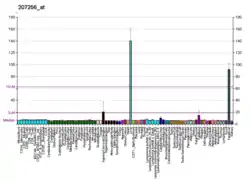لکتین متصلشونده به مانان
لکتین متصلشونده به مانان (انگلیسی: Mannose-binding lectin) یا «لکتین متصلشونده به مانوز» یا «MBL» که با عناوینی همچون «پروتئین متصلشونده به مانوز» و «پروتئین متصلشونده به مانان» (MBP) هم شناخته میشود، نوعی لکتین است که وجودش برای دستگاه ایمنی ذاتی حیاتی است[1][2] و از طریق «راه لکتین» عمل میکند.
| Mannose binding lectin 2 | |||||||||||||||
|---|---|---|---|---|---|---|---|---|---|---|---|---|---|---|---|
| معینکنندهها | |||||||||||||||
| نامهای دیگر | Mannose-binding lectinMannan-binding proteinmannan-binding lectinmannose-binding lectin (protein C) 2soluble (opsonic defect)mannose-binding lectin 2soluble (opsonic defect)mannose-binding protein Ccollectin-1MBL2MBP1mannose-binding lectinMBL | ||||||||||||||
| شناسههای بیرونی | GeneCards: | ||||||||||||||
| |||||||||||||||
| همساختشناسی | |||||||||||||||
| گونهها | انسان | موش | |||||||||||||
| Entrez |
|
| |||||||||||||
| آنسامبل |
|
| |||||||||||||
| یونیپروت |
|
| |||||||||||||
| RefSeq (mRNA) |
|
| |||||||||||||
| RefSeq (پروتئین) |
|
| |||||||||||||
| موقعیت (UCSC) | n/a | n/a | |||||||||||||
| جستجوی PubMed | n/a | n/a | |||||||||||||
| ویکیداده | |||||||||||||||
| |||||||||||||||
لکتین متصلشونده به مانوز ساختمان اُلیگومری دارد (با وزن حدود ۴۰۰ تا ۷۰۰ کیلو دالتون) که از سه زنجیرهٔ پپتیدی مشابه با وزن تقریبی ۳۰ کیلو دالتون تشکیل شدهاست.
با آنکه این مولکول قادر است چندین فرم اُلیگومری بسازد، اما برای آنکه قادر به فعالسازی سیستم کمپلمان باشد، باید دستکم ساختمان تترامری (چهارتایی) داشته باشد.[3]
ژن انسانی «MBL2» بر روی کروموزم شماره ۱۰ واقع شدهاست[4] و در مواقع عفونت، توسط کبد ساخته میشود و بخشی از پروتئین فاز حاد است.[5] بیان ژنی و عملکرد این مولکول در بخشهای دیگر بدن هم مورد توجه واقع شدهاست.[6] سه نوع پلیمرفیسم مختلفِ اگزون ۱ این ژن، فرد را مستعد عفونتهای گوناگون و از جمله بیماریهای مننگوکوکی میکند.[7][8] البته شواهدی هم بدست آمدهاست که این واریانهای ژنی، هیچگونه اثر سوئی در ارتباط با بیماری مننگوکوکی ایجاد نخواهد کرد.[9]
این پروتئین قادر است به موارد زیر متصل شود:
- مخمرها نظیر کاندیدا آلبیکانس[10]
- ویروسها نظیر اچآیوی[11] و آنفلوآنزای نوع A
- بسیاری از باکتریها همچون استرپتوکوک و سالمونلا
- انگلها نظیر لیشمانیا
این اتصال از طریق باقیماندهٔ «D-مانوز» و «L-فروکتوز» موجود در سطح این پاتوژنها انجام میپذیرد.
منابع
- Fraser IP, Koziel H, Ezekowitz RA (1998). "The serum mannose-binding protein and the macrophage mannose receptor are pattern recognition molecules that link innate and adaptive immunity". Semin. Immunol. 10 (5): 363–72. doi:10.1006/smim.1998.0141. PMID 9799711.
- Worthley DL, Bardy PG, Mullighan CG (2005). "Mannose-binding lectin: biology and clinical implications". Internal medicine journal. 35 (9): 548–55. doi:10.1111/j.1445-5994.2005.00908.x. PMID 16105157.
- Sheriff S, Chang CY, Ezekowitz RA (November 1994). "Human mannose-binding protein carbohydrate recognition domain trimerizes through a triple alpha-helical coiled-coil". Nat. Struct. Biol. 1 (11): 789–94. doi:10.1038/nsb1194-789. PMID 7634089.
- Sastry K, Herman GA, Day L, Deignan E, Bruns G, Morton CC, Ezekowitz RA (October 1989). "The human mannose-binding protein gene. Exon structure reveals its evolutionary relationship to a human pulmonary surfactant gene and localization to chromosome 10". J. Exp. Med. 170 (4): 1175–89. doi:10.1084/jem.170.4.1175. PMC 2189467. PMID 2477486.
- Herpers, B L; Endeman, H; de Jong, B A W; de Jongh, B M; Grutters, J C; Biesma, D H; vam Velzen-Blad, H (Jun 2009). "Acute-phase responsiveness of mannose-binding lectin in community-acquired pneumonia is highly dependent upon MBL2 genotypes". Clin Exp Immunol. 156 (3): 488–94. doi:10.1111/j.1365-2249.2009.03929.x. PMC 2691978. PMID 19438602.
- Worthley DL, Bardy PG, Gordon DL, Mullighan CG (October 2006). "Mannose-binding lectin and maladies of the bowel and liver". World J. Gastroenterol. 12 (40): 6420–8. PMID 17072973.
- Hibberd, M. L.; Sumiya, M.; Summerfield, J. A.; Booy, R.; Levin, M. (1999). "Association of variants of the gene for mannose-binding lectin with susceptibility to meningococcal disease". The Lancet. 353 (9158): 1049. doi:10.1016/S0140-6736(98)08350-0.
- Faber, J.; Schuessler, T.; Finn, A.; Murdoch, C.; Zenz, W.; Habermehl, P.; Meyer, C. U.; Zabel, B. U.; Schmitt, H. J.; Zepp, F.; Knuf, M. (2007). "Age-Dependent Association of Human Mannose-Binding Lectin Mutations with Susceptibility to Invasive Meningococcal Disease in Childhood". The Pediatric Infectious Disease Journal. 26 (3): 243–246. doi:10.1097/01.inf.0000256751.76218.7c. PMID 17484222.
- Bradley, D. T.; Bourke, T. W.; Fairley, D. J.; Borrow, R.; Shields, M. D.; Young, I. S.; Zipfel, P. F.; Hughes, A. E. (2012). "Genetic susceptibility to invasive meningococcal disease: MBL2 structural polymorphisms revisited in a large case-control study and a systematic review". International Journal of Immunogenetics: no. doi:10.1111/j.1744-313X.2012.01095.x.
- de Jong MA, Vriend LE, Theelen B, Taylor ME, Fluitsma D, Boekhout T, Geijtenbeek TB (March 2010). "C-type lectin Langerin is a beta-glucan receptor on human Langerhans cells that recognizes opportunistic and pathogenic fungi". Mol. Immunol. 47 (6): 1216–25. doi:10.1016/j.molimm.2009.12.016. PMC 2837148. PMID 20097424.
- Ji X, Gewurz H, Spear GT (February 2005). "Mannose binding lectin (MBL) and HIV". Mol. Immunol. 42 (2): 145–52. doi:10.1016/j.molimm.2004.06.015. PMID 15488604.
- مشارکتکنندگان ویکیپدیا. «Mannan-binding lectin». در دانشنامهٔ ویکیپدیای انگلیسی، بازبینیشده در ۱۳ اکتبر ۲۰۱۷.
پیوند به بیرون
- Mannan-Binding Lectin در سرعنوانهای موضوعی پزشکی (MeSH) در کتابخانهٔ ملی پزشکی ایالات متحدهٔ آمریکا
